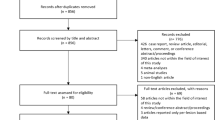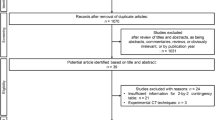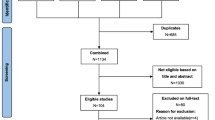Abstract
Objectives
To identify reliable MRI features for differentiating autoimmune pancreatitis (AIP) from pancreatic ductal adenocarcinoma (PDAC) and to summarize their diagnostic accuracy.
Methods
We conducted a systematic literature review and meta-analysis using PubMed, EMBASE, and the Cochrane Library to identify original articles published between January 2006 and July 2021. The pooled diagnostic accuracy, including the diagnostic odds ratios (DORs) with 95% confidence intervals (CIs) of the identified features, was calculated using a bivariate random effects model.
Results
Twelve studies were included, and 92 overlapping descriptors were subsumed under 16 MRI features. Ten features favoring AIP were diffuse enlargement (DOR, 75; 95% CI, 9–594), capsule-like rim (DOR, 52; 95% CI, 20–131), multiple main pancreatic duct (MPD) strictures (DOR, 47; 95% CI, 17–129), homogeneous delayed enhancement (DOR, 46; 95% CI, 21–104), low apparent diffusion coefficient value (DOR, 30), speckled enhancement (DOR, 30), multiple pancreatic masses (DOR, 29), tapered narrowing of MPD (DOR, 15), penetrating duct sign (DOR, 14), and delayed enhancement (DOR, 13). Six features favoring PDAC were target type enhancement (DOR, 41; 95% CI, 11–158), discrete pancreatic mass (DOR, 35; 95% CI, 15–80), upstream MPD dilatation (DOR, 13), peripancreatic fat infiltration (DOR, 10), upstream parenchymal atrophy (DOR, 5), and vascular involvement (DOR, 3).
Conclusion
This study identified 16 informative MRI features to differentiate AIP from PDAC. Among them, diffuse enlargement, capsule-like rim, multiple MPD strictures, and homogeneous delayed enhancement favored AIP with the highest DORs, whereas discrete mass and target type enhancement favored PDAC.
Key Points
• The MRI features with the highest pooled diagnostic odds ratios (DORs) for autoimmune pancreatitis were diffuse enlargement of the pancreas (75), capsule-like rim (52), multiple strictures of the main pancreatic duct (47), and homogeneous delayed enhancement (46).
• The MRI features with the highest pooled DORs for pancreatic ductal adenocarcinoma were target type enhancement (41) and discrete pancreatic mass (35).






Similar content being viewed by others
Abbreviations
- ADC :
-
Apparent diffusion coefficient
- AIP :
-
Autoimmune pancreatitis
- CI:
-
Confidence interval
- DOR:
-
Diagnostic odds ratio
- DWI:
-
Diffusion-weighted imaging
- MPD:
-
Main pancreatic duct
- MRCP :
-
Magnetic resonance cholangiopancreatography
- NLR :
-
Negative likelihood ratio
- PDAC :
-
Pancreatic ductal adenocarcinoma
- PLR :
-
Positive likelihood ratio
References
Kamisawa T, Zen Y, Nakazawa T, Okazaki K (2018) Advances in IgG4-related pancreatobiliary diseases. Lancet Gastroenterol Hepatol 3:575–585
Nagpal SJS, Sharma A, Chari ST (2018) Autoimmune pancreatitis. Am J Gastroenterol 113:1301
Shimosegawa T, Chari ST, Frulloni L et al (2011) International consensus diagnostic criteria for autoimmune pancreatitis: guidelines of the International Association of Pancreatology. Pancreas 40:352–358
Wallace ZS, Naden RP, Chari S et al (2020) The 2019 American College of Rheumatology/European League Against Rheumatism classification criteria for IgG4-related disease. Ann Rheum Dis 79:77–87
Chari ST, Takahashi N, Levy MJ et al (2009) A diagnostic strategy to distinguish autoimmune pancreatitis from pancreatic cancer. Clin Gastroenterol Hepatol 7:1097–1103
Moon SH, Kim MH, Park DH et al (2008) Is a 2-week steroid trial after initial negative investigation for malignancy useful in differentiating autoimmune pancreatitis from pancreatic cancer? A prospective outcome study. Gut 57:1704–1712
Sahani DV, Sainani NI, Deshpande V, Shaikh MS, Frinkelberg DL, Fernandez-del Castillo C (2009) Autoimmune pancreatitis: disease evolution, staging, response assessment, and CT features that predict response to corticosteroid therapy. Radiology 250:118–129
Javed AA, Wright MJ, Ding D et al (2021) Autoimmune pancreatitis: a critical analysis of the surgical experience in an era of modern diagnostics. Pancreas 50:556–563
Yoon SB, Moon SH, Song TJ, Kim JH, Kim MH (2021) Endoscopic ultrasound-guided fine needle aspiration versus biopsy for diagnosis of autoimmune pancreatitis: systematic review and comparative meta-analysis. Dig Endosc 33:1024–1033
Takahashi N, Fletcher JG, Hough DM et al (2009) Autoimmune pancreatitis: differentiation from pancreatic carcinoma and normal pancreas on the basis of enhancement characteristics at dual-phase CT. AJR Am J Roentgenol 193:479–484
Lee S, Kim JH, Kim SY et al (2018) Comparison of diagnostic performance between CT and MRI in differentiating non-diffuse-type autoimmune pancreatitis from pancreatic ductal adenocarcinoma. Eur Radiol 28:5267–5274
Ha J, Choi SH, Byun JH et al (2021) Meta-analysis of CT and MRI for differentiation of autoimmune pancreatitis from pancreatic adenocarcinoma. Eur Radiol 31:3427–3438
Kamisawa T, Takuma K, Anjiki H et al (2010) Differentiation of autoimmune pancreatitis from pancreatic cancer by diffusion-weighted MRI. Am J Gastroenterol 105:1870–1875
Kim HJ, Kim YK, Jeong WK, Lee WJ, Choi D (2015) Pancreatic duct "Icicle sign" on MRI for distinguishing autoimmune pancreatitis from pancreatic ductal adenocarcinoma in the proximal pancreas. Eur Radiol 25:1551–1560
Kwon JH, Kim JH, Kim SY et al (2019) Differentiating focal autoimmune pancreatitis and pancreatic ductal adenocarcinoma: contrast-enhanced MRI with special emphasis on the arterial phase. Eur Radiol 29:5763–5771
Furuhashi N, Suzuki K, Sakurai Y, Ikeda M, Kawai Y, Naganawa S (2015) Differentiation of focal-type autoimmune pancreatitis from pancreatic carcinoma: assessment by multiphase contrast-enhanced CT. Eur Radiol 25:1366–1374
Takahashi M, Fujinaga Y, Notohara K et al (2020) Diagnostic imaging guide for autoimmune pancreatitis. Jpn J Radiol 38:591–612
Page MJ, McKenzie JE, Bossuyt PM et al (2021) The PRISMA 2020 statement: an updated guideline for reporting systematic reviews. BMJ 372:n71
Schardt C, Adams MB, Owens T, Keitz S, Fontelo P (2007) Utilization of the PICO framework to improve searching PubMed for clinical questions. BMC Med Inform Decis Mak 7:16
Whiting PF, Rutjes AW, Westwood ME et al (2011) QUADAS-2: a revised tool for the quality assessment of diagnostic accuracy studies. Ann Intern Med 155:529–536
You MW, Yun SJ (2019) Differentiating between hepatocellular carcinoma and intrahepatic cholangiocarcinoma using contrast-enhanced MRI features: a systematic review and meta-analysis. Clin Radiol 74:406 e409–406 e418
Kim HY, Park JH, Lee YJ, Lee SS, Jeon JJ, Lee KH (2018) Systematic review and meta-analysis of CT features for differentiating complicated and uncomplicated appendicitis. Radiology 287:104–115
Park SH, Kim MH, Kim SY et al (2010) Magnetic resonance cholangiopancreatography for the diagnostic evaluation of autoimmune pancreatitis. Pancreas 39:1191–1198
Hur BY, Lee JM, Lee JE et al (2012) Magnetic resonance imaging findings of the mass-forming type of autoimmune pancreatitis: comparison with pancreatic adenocarcinoma. J Magn Reson Imaging 36:188–197
Naitoh I, Nakazawa T, Hayashi K et al (2012) Clinical differences between mass-forming autoimmune pancreatitis and pancreatic cancer. Scand J Gastroenterol 47:607–613
Muhi A, Ichikawa T, Motosugi U et al (2012) Mass-forming autoimmune pancreatitis and pancreatic carcinoma: differential diagnosis on the basis of computed tomography and magnetic resonance cholangiopancreatography, and diffusion-weighted imaging findings. J Magn Reson Imaging 35:827–836
Sugiyama Y, Fujinaga Y, Kadoya M et al (2012) Characteristic magnetic resonance features of focal autoimmune pancreatitis useful for differentiation from pancreatic cancer. Jpn J Radiol 30:296–309
Sun GF, Zuo CJ, Shao CW, Wang JH, Zhang J (2013) Focal autoimmune pancreatitis: radiological characteristics help to distinguish from pancreatic cancer. World J Gastroenterol 19:3634–3641
Choi SY, Kim SH, Kang TW, Song KD, Park HJ, Choi YH (2016) Differentiating mass-forming autoimmune pancreatitis from pancreatic ductal adenocarcinoma on the basis of contrast-enhanced MRI and DWI findings. AJR Am J Roentgenol 206:291–300
Sekito T, Ishii Y, Serikawa M et al (2021) The role of apparent diffusion coefficient value in the diagnosis of localized type 1 autoimmune pancreatitis: differentiation from pancreatic ductal adenocarcinoma and evaluation of response to steroids. Abdom Radiol (NY) 46:2014–2024
Choi YJ, Byun JH, Kim JY et al (2008) Diffuse pancreatic ductal adenocarcinoma: characteristic imaging features. Eur J Radiol 67:321–328
Ishigami K, Tajima T, Nishie A et al (2010) MRI findings of pancreatic lymphoma and autoimmune pancreatitis: a comparative study. Eur J Radiol 74:e22–e28
Triantopoulou C, Kolliakou E, Karoumpalis I, Yarmenitis S, Dervenis C (2012) Metastatic disease to the pancreas: an imaging challenge. Insights Imaging 3:165–172
Manfredi R, Frulloni L, Mantovani W, Bonatti M, Graziani R, Pozzi Mucelli R (2011) Autoimmune pancreatitis: pancreatic and extrapancreatic MR imaging-MR cholangiopancreatography findings at diagnosis, after steroid therapy, and at recurrence. Radiology 260:428–436
Kawa S, Kamisawa T, Notohara K et al (2020) Japanese Clinical Diagnostic Criteria for Autoimmune Pancreatitis, 2018: Revision of Japanese Clinical Diagnostic Criteria for Autoimmune Pancreatitis, 2011. Pancreas 49:e13–e14
Kim JH, Byun JH, Kim MH et al (2017) Pancreatic duct in autoimmune pancreatitis: intraindividual comparison of magnetic resonance pancreatography at 1.5 T and 3.0 T. Pancreas 46:921–926
Lee SC, Yang CH, Chang CT, Yu KH (2021) Diagnostic utility of serum IgG4 in autoimmune pancreatitis: an updated comprehensive systematic review and meta-analysis. J Clin Gastroenterol. https://doi.org/10.1097/MCG.0000000000001612
Gardner TB, Levy MJ, Takahashi N, Smyrk TC, Chari ST (2009) Misdiagnosis of autoimmune pancreatitis: a caution to clinicians. Am J Gastroenterol 104:1620–1623
Kanno A, Nishimori I, Masamune A et al (2012) Nationwide epidemiological survey of autoimmune pancreatitis in Japan. Pancreas 41:835–839
Takahashi N, Fletcher JG, Fidler JL, Hough DM, Kawashima A, Chari ST (2008) Dual-phase CT of autoimmune pancreatitis: a multireader study. AJR Am J Roentgenol 190:280–286
Author information
Authors and Affiliations
Corresponding author
Ethics declarations
Guarantor
The scientific guarantor of this publication is Sung-Hoon Moon.
Conflict of interest
The authors of this manuscript declare no relationships with any companies whose products or services may be related to the subject matter of the article.
Statistics and biometry
One of the authors (Seung Bae Yoon) has significant statistical expertise.
Informed consent
Written informed consent was not required for this study because this study was a systematic review and meta-analysis.
Ethical approval
Institutional Review Board approval was not required because this study was a systematic review and meta-analysis.
Methodology
• diagnostic or prognostic study
• multicenter study
Additional information
Publisher’s note
Springer Nature remains neutral with regard to jurisdictional claims in published maps and institutional affiliations.
Supplementary information
Supplementary Figure 1
(PNG 81 kb)
Supplementary Figure 2
(PNG 681 kb)
Supplementary Figure 3
(PNG 626 kb)
ESM 1
(DOCX 24 kb)
ESM 2
(DOCX 17 kb)
ESM 3
(DOCX 69 kb)
ESM 4
(DOCX 36 kb)
ESM 5
(DOCX 21 kb)
ESM 6
(DOCX 19 kb)
ESM 7
(DOCX 19 kb)
ESM 8
(DOCX 19 kb)
ESM 9
(DOCX 19 kb)
ESM 10
(DOCX 19 kb)
ESM 11
(DOCX 19 kb)
ESM 12
(DOCX 19 kb)
Rights and permissions
About this article
Cite this article
Yoon, S.B., Jeon, T.Y., Moon, SH. et al. Systematic review and meta-analysis of MRI features for differentiating autoimmune pancreatitis from pancreatic adenocarcinoma. Eur Radiol 32, 6691–6701 (2022). https://doi.org/10.1007/s00330-022-08816-1
Received:
Revised:
Accepted:
Published:
Issue Date:
DOI: https://doi.org/10.1007/s00330-022-08816-1




